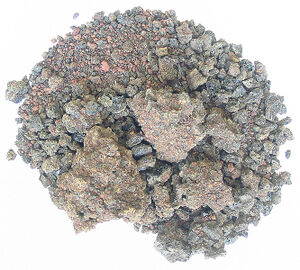Tephra (nonfiction): Difference between revisions
No edit summary |
|||
| (4 intermediate revisions by the same user not shown) | |||
| Line 1: | Line 1: | ||
'''Tephra''' is fragmental material produced by a volcanic eruption regardless of composition, fragment size or emplacement mechanism. | [[File:Tephra_La_Palma.jpg|thumb|Tephra from La Palma.]]'''Tephra''' is fragmental material produced by a volcanic eruption regardless of composition, fragment size or emplacement mechanism. | ||
Volcanologists also refer to airborne fragments as pyroclasts. | Volcanologists also refer to airborne fragments as pyroclasts. | ||
Once clasts have fallen to the ground they remain as tephra unless hot enough to fuse together into pyroclastic rock or tuff. | Once clasts have fallen to the ground they remain as tephra unless hot enough to fuse together into pyroclastic rock or tuff. | ||
The distribution of tephra following an eruption usually involves the largest boulders falling to the ground quickest and therefore closest to the vent, while smaller fragments travel further — ash can often travel for thousands of miles, even circumglobal, as it can stay in the stratosphere for days to weeks following an eruption. | The distribution of tephra following an eruption usually involves the largest boulders falling to the ground quickest and therefore closest to the vent, while smaller fragments travel further — ash can often travel for thousands of miles, even circumglobal, as it can stay in the stratosphere for days to weeks following an eruption. | ||
| Line 14: | Line 10: | ||
Tephra mixed in with precipitation can also be acidic and cause acid rain and snowfall. | Tephra mixed in with precipitation can also be acidic and cause acid rain and snowfall. | ||
Tephra fragments are classified by size: | Tephra fragments are classified by size: | ||
* Ash – particles smaller than 2 mm (0.08 inches) in diameter, | * Ash – particles smaller than 2 mm (0.08 inches) in diameter, | ||
* [[Lapilli ( | * [[Lapilli (nonfiction)]] or volcanic cinders – between 2 and 64 mm (0.08 and 2.5 inches) in diameter, | ||
* Volcanic bombs or volcanic blocks – larger than 64 mm (2.5 inches) in diameter. | * Volcanic bombs or volcanic blocks – larger than 64 mm (2.5 inches) in diameter. | ||
The use of tephra layers, which bear their own unique chemistry and character, as temporal marker horizons in archaeological and geological sites is known as tephrochronology. | The use of tephra layers, which bear their own unique chemistry and character, as temporal marker horizons in archaeological and geological sites is known as tephrochronology. | ||
== | The word "tephra" and "pyroclast" both derive from Greek: τέφρα ''tephra'' means "ash", while the word pyroclast is derived from the Greek πῦρ (''pyr''), meaning "fire", and κλαστός (''klastos''), meaning "broken in pieces". | ||
== In the News == | |||
<gallery mode="traditional"> | |||
</gallery> | |||
== Fiction cross-reference == | |||
* [[Chicxulub Chips]] | |||
== Nonfiction cross-reference == | |||
* [[Tephrochronology (nonfiction)]] | |||
External links: | |||
* [http://wiki.karljones.com/index.php?title=Tephra Tephra] @ wiki.karljones.com | * [http://wiki.karljones.com/index.php?title=Tephra Tephra] @ wiki.karljones.com | ||
Latest revision as of 07:29, 23 June 2016
Tephra is fragmental material produced by a volcanic eruption regardless of composition, fragment size or emplacement mechanism.
Volcanologists also refer to airborne fragments as pyroclasts.
Once clasts have fallen to the ground they remain as tephra unless hot enough to fuse together into pyroclastic rock or tuff.
The distribution of tephra following an eruption usually involves the largest boulders falling to the ground quickest and therefore closest to the vent, while smaller fragments travel further — ash can often travel for thousands of miles, even circumglobal, as it can stay in the stratosphere for days to weeks following an eruption.
When large amounts of tephra accumulate in the atmosphere from massive volcanic eruptions (or from a multitude of smaller eruptions occurring simultaneously), they can reflect light and heat from the sun back through the atmosphere, in some cases causing the temperature to drop, resulting in a temporary, "volcanic winter", climate change.
Tephra mixed in with precipitation can also be acidic and cause acid rain and snowfall.
Tephra fragments are classified by size:
- Ash – particles smaller than 2 mm (0.08 inches) in diameter,
- Lapilli (nonfiction) or volcanic cinders – between 2 and 64 mm (0.08 and 2.5 inches) in diameter,
- Volcanic bombs or volcanic blocks – larger than 64 mm (2.5 inches) in diameter.
The use of tephra layers, which bear their own unique chemistry and character, as temporal marker horizons in archaeological and geological sites is known as tephrochronology.
The word "tephra" and "pyroclast" both derive from Greek: τέφρα tephra means "ash", while the word pyroclast is derived from the Greek πῦρ (pyr), meaning "fire", and κλαστός (klastos), meaning "broken in pieces".
In the News
Fiction cross-reference
Nonfiction cross-reference
External links:
